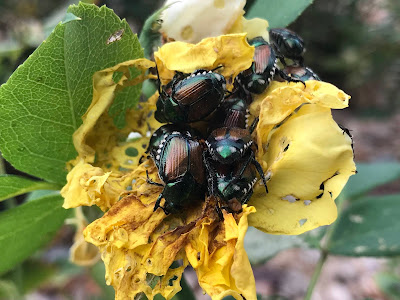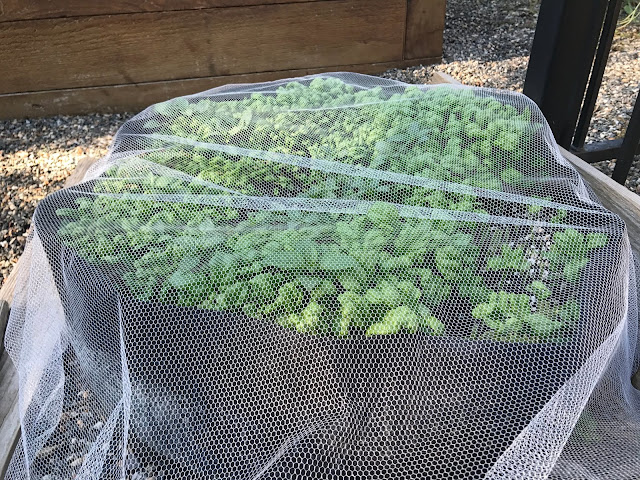Japanese beetles arrived in New Jersey (from Japan) in 1916 and didn't make it to Colorado for almost one hundred years. I've been battling Japanese beetles in our landscape for over seven years, it seems longer.
Managing Japanese beetles and their offspring white grubs (next year's generation) is very doable and might ease your frustration of seeing your favorite plants chewed or defoliated.
Hand picking, or flicking adult beetles into a soapy death bath is easy and provides immediate satisfaction. Use an old can or plastic bucket and drain the contents and toss every few days, they get stinky. Chickens, ducks and goats will gladly munch on Japanese beetles for an all day snack - they can't reach tall plants on their own, however. Some birds like grackles and starlings are reported to eat JBs, but I've never seen them in the act in my yard.
 |
| 4000+ Drowned Dead Japanese Beetles (2 days worth) |
There are several over the counter products to mix and spray on adult beetles, but timing is very important so bees and other valuable pollinators are protected. First, read the product label, mix correctly and use with caution and care.
Dr. Whitney Cranshaw's fact sheet on Japanese Beetles is a helpful resource on the many products available, their chemical names, trade names and other information about using on food crops and comments about pollinators. Click here. Print a copy, circle what your time frame and pocket book will allow. Some products can be pricey and most of them need to be sprayed every few days or so.
Right now is the optimum time to put down a product in lawns to kill the eggs and white grubs (next year's beetles). Don't wait much longer. Only one product is needed per summer. Again, read all the package instructions, refer to the fact sheet for all the available products. Two products are very low to no impact to beneficial insects, people, pets, etc. Beneficial nematodes (mix and spray) and grubGONE! (granular application with spreader). Both products should be available locally at reputable independent garden centers or online.
There is long-term good news on the Japanese beetle battle. Dr. Cranshaw and the Colorado Department of Agriculture are responsible for bringing biocontrols that specifically attack adult beetles and or white grubs to Denver, Boulder and Pueblo. I wrote about the three controls last summer in a Denver Post article, read here. Efforts are continuing this summer for additional releases and testing to see if any of the controls are getting established, stay tuned!
Additional Resources:
Japanese Beetle Management in Colorado - My Dedicated Japanese Beetle Website
Plants - From Resistance to Extensive Feeding
Japanese Beetle Fact Sheet 5.601 - Dr. Whitney Cranshaw
My Next Japanese Beetle Class at Denver Botanic Gardens, August 10, 2019. My last JB class of the year, look for the class again next winter and spring at Denver Botanic Gardens.








